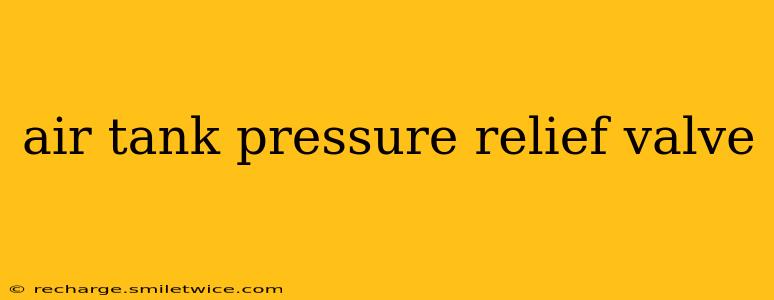Air tank pressure relief valves are crucial safety devices preventing dangerous pressure buildup in compressed air systems. Understanding their function, types, and maintenance is vital for ensuring workplace safety and equipment longevity. This comprehensive guide delves into the intricacies of air tank pressure relief valves, answering common questions and providing valuable insights for professionals and enthusiasts alike.
What is an Air Tank Pressure Relief Valve?
An air tank pressure relief valve, also known as a pressure relief valve (PRV), safety valve, or pressure safety valve, is a safety device designed to automatically release pressure from a compressed air tank when it exceeds a predetermined set point. This prevents overpressurization, which could lead to tank rupture, explosions, and serious injury. These valves are essential components in any system utilizing compressed air, from industrial settings to smaller applications. They act as a fail-safe mechanism, protecting both equipment and personnel.
How Does an Air Tank Pressure Relief Valve Work?
The operation is relatively straightforward. The valve incorporates a spring-loaded mechanism that holds a valve disc or poppet closed until the pressure within the tank reaches the pre-set pressure limit. When this limit is exceeded, the pressure overcomes the spring force, opening the valve and allowing compressed air to escape until the pressure falls below the set point. The valve then automatically closes, sealing the tank once again. The pressure setting is typically adjusted via a screw mechanism on the valve itself, allowing for customization to specific system requirements.
What are the Different Types of Air Tank Pressure Relief Valves?
Several types of pressure relief valves exist, each designed for specific applications and pressure ranges. Common types include:
-
Spring-loaded Valves: These are the most common type, relying on a spring to regulate pressure. They are relatively simple, reliable, and cost-effective.
-
Pilot-operated Valves: These valves use a secondary pressure signal to control the main valve, offering more precise pressure regulation and control.
-
Weight-loaded Valves: Less common in modern compressed air systems, these valves utilize a weight to counterbalance the pressure, providing a simpler, albeit less adjustable, mechanism.
What is the Difference Between a Pressure Relief Valve and a Pressure Reducing Valve?
While both deal with pressure control, their functions differ significantly. A pressure relief valve is a safety device that releases excess pressure to prevent overpressurization and potential damage. A pressure reducing valve, on the other hand, regulates pressure to a specific lower level, maintaining a consistent downstream pressure. They are not interchangeable and serve distinct purposes within a compressed air system.
How Often Should I Inspect My Air Tank Pressure Relief Valve?
Regular inspection is paramount for safety. The frequency depends on the application and local regulations, but a monthly visual inspection, including checking for leaks, corrosion, and damage, is recommended as a minimum. More frequent inspections might be necessary in high-use or harsh environments. Furthermore, professional testing and certification should be conducted periodically according to industry best practices and regulatory requirements.
How Do I Test an Air Tank Pressure Relief Valve?
Testing the valve involves verifying its proper operation at its set pressure. While some valves may have manual testing mechanisms, others may require specialized equipment and expertise for accurate testing. It's crucial to consult the manufacturer's instructions for specific testing procedures and never attempt to tamper with or modify the valve without proper knowledge. Improper testing can compromise the valve's safety function.
What Happens if My Air Tank Pressure Relief Valve Fails?
Failure of the pressure relief valve can have severe consequences. The most significant risk is a catastrophic failure of the air tank due to overpressurization. This can lead to tank rupture, releasing high-pressure air and potentially causing significant damage and injury. Regular inspections and maintenance are crucial in preventing such failures.
Conclusion
Air tank pressure relief valves are indispensable safety components in any compressed air system. Understanding their function, types, and maintenance is crucial for ensuring both equipment longevity and workplace safety. Regular inspections, proper testing, and adherence to safety guidelines are vital for preventing accidents and ensuring the reliable operation of your compressed air system. Always consult manufacturer specifications and local regulations for specific requirements and maintenance schedules.
